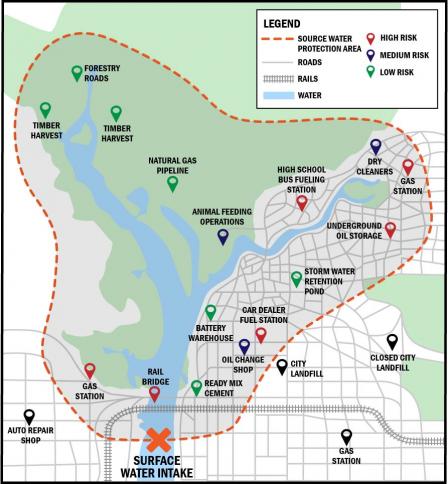Determine Susceptibility to Contaminant Sources
What is a Susceptibility Determination?
The third and last step in a source water assessment is to perform a risk analysis to determine the susceptibility of the public water system to current and potential sources of contamination identified in the inventory. The risk analysis provides a ranking of source water threats that is used to select protection measures that address the highest priority threats.
 Prioritize Risks to Drinking Water
Prioritize Risks to Drinking Water
Drinking water systems use a range of criteria to rank source water threats and determine susceptibility to contamination1, including
- The likelihood that contaminants will be released from a source and contaminate the source water;
- The vulnerability of the public water system and probability that it would be impacted by source water contamination; and
- The potential consequences of source water contamination experienced by the public water system (such as increased water treatment costs and regulatory compliance) or its customers (such as illness).
Access EPA's Online Source Water Quality Monitoring for SRSs to learn more about methods for assessing susceptibility to source water threats.
Characterizing Source Water Threats
Public water systems use a variety of information about potential sources of contamination, such as the natural setting and the utility's infrastructure and operation, to complete susceptibility determinations.
Examples of this information include:
- Location of the potential contaminant source and its distance to the source water;
- Contaminants associated with the potential contaminant source;
- Quantities of contaminants stored at the location or discharge rates from a potential contaminant source;
- Characteristics and properties of the potential contaminants stored at the location (such as solubility and toxicity);
- Estimates of contaminant dispersion and dilution in the source water (such as contaminant fate and transport);
- Existing risk mitigation strategies to protect the source water from the threat (such as leak detection, spill containment, and runoff control);
- Physical integrity and characteristics of the well or intake (such as cracks or breaks in the well structure); and,
- Sensitivity of the natural setting (such as presence/absence of confining layers and natural transport pathways).
The table below lists examples of potential sources of contamination and additional factors that may be used to make a susceptibility determination.
| Contaminant/Activity | Distance from Intake | Contaminants | Risk Reducing Factors | Threat Level |
|---|---|---|---|---|
| Failing septic tank | Within 300 feet | Nitrate, sulfate, coliform | Remove or repair tanks | High |
| Livestock | 1000 feet | Nitrate, sulfate, coliform, sediment | Exclusion fences | Low |
| Road salt storage | 600 feet | Chloride | Diked facility with berms | Medium |
Learn more about other components of source water protection programs.
1Parameters are derived from EPA's Online Source Water Quality Monitoring for Water Quality Surveillance Response Systems (SRS) and the American Water Works Association (AWWA) J100 Standard).
